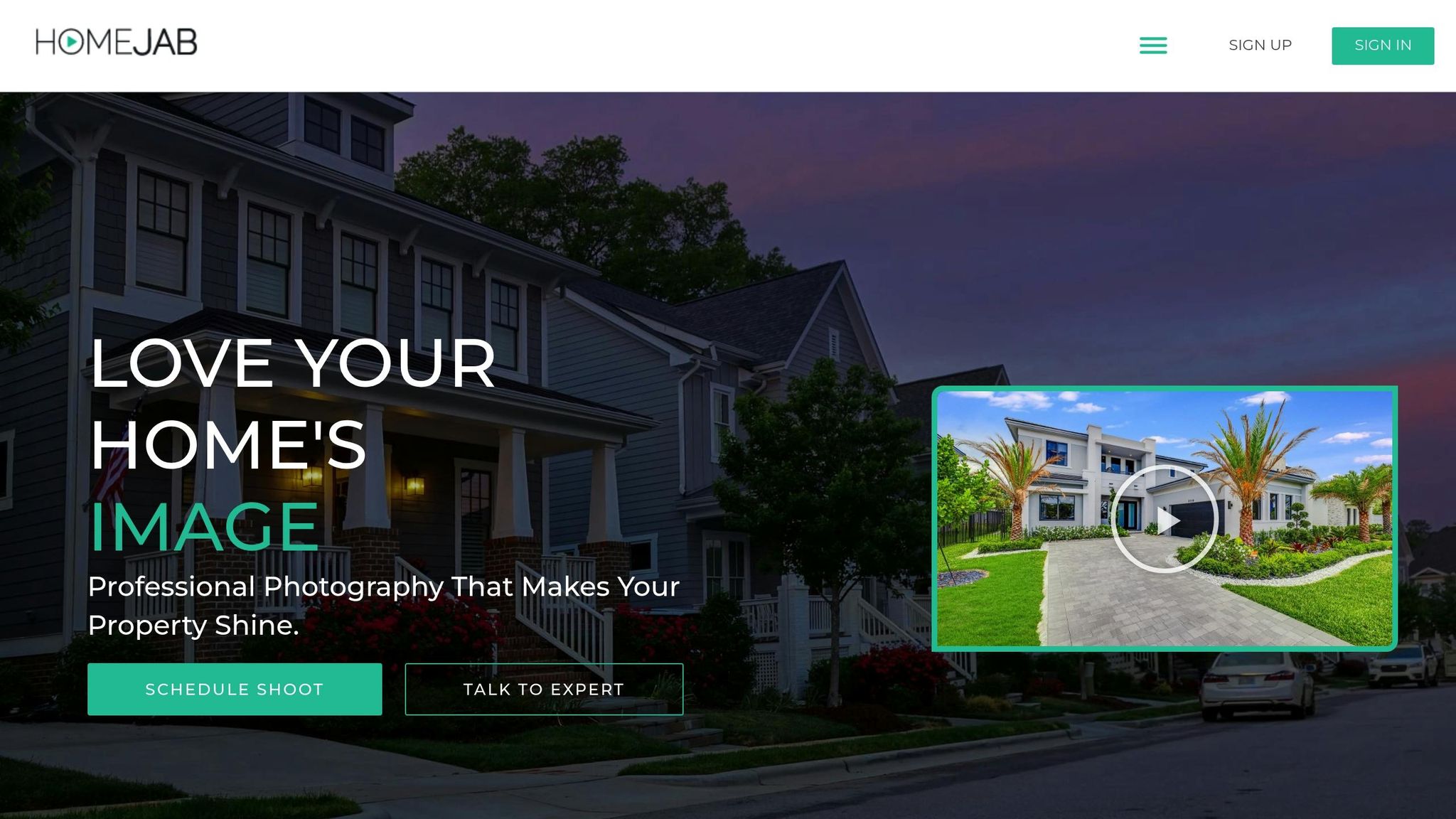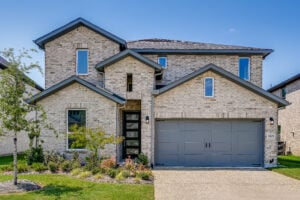Thermal drone cameras combine infrared imaging with aerial technology to detect temperature variations in properties, making them invaluable for inspections. They identify issues like water leaks, insulation gaps, and HVAC inefficiencies quickly and safely. These tools are especially useful in real estate, offering detailed insights into a property’s condition without disrupting the space. Here’s what you need to know:
- Key Features: Infrared resolution (e.g., 320×240 or 640×512), thermal sensitivity (30mK–50mK), and temperature range (-4°F to 752°F) ensure accurate results.
- Applications: Spotting roof leaks, evaluating energy efficiency, diagnosing HVAC and electrical problems, and documenting findings for buyers and sellers.
- Pros: Safe, efficient, and effective for large or hard-to-reach areas. Works in low light and provides thorough reports.
- Cons: High costs, weather limitations, and the need for specialized training.
For real estate professionals, thermal drones streamline inspections and offer precise data, helping buyers and sellers make informed decisions.
Teledyne FLIR SIRAS – Thermal Camera Settings & Features – Florida Drone Supply
Key Features of Thermal Drone Cameras for Real Estate
This section highlights the essential specifications of thermal drone cameras that influence inspection quality and their role in property assessments.
Infrared Sensor Resolution and Sensitivity
The resolution of a thermal camera determines the level of detail in each image. Common options include 160×120, 320×240, and 640×512 pixels. For most real estate tasks, 320×240 resolution provides enough detail for standard inspections. However, for more complex assessments – like evaluating intricate features such as rooflines, window frames, or HVAC systems – a higher resolution of 640×512 delivers sharper, professional-grade clarity.
Thermal sensitivity, expressed in millikelvin (mK), measures the smallest temperature differences a camera can detect. High-quality thermal drone cameras typically offer sensitivity between 30mK and 50mK. A sensitivity of 30mK, for example, can detect temperature changes as small as 0.054°F. This level of precision is especially useful for identifying subtle issues, such as early-stage moisture problems or small insulation gaps.
This sensitivity is particularly valuable when inspecting newer properties, where temperature variations might still be minimal, or when conducting energy efficiency evaluations to pinpoint areas needing improvement. Both resolution and sensitivity significantly impact the accuracy and scope of temperature measurements.
Temperature Measurement Range and Accuracy
The temperature measurement range defines the span of temperatures a camera can detect. Thermal drone cameras used in real estate typically measure temperatures from -4°F to 752°F (-20°C to 400°C). This range is broad enough to capture everything from cold spots caused by air leaks to overheating electrical components or sun-exposed roof surfaces.
Temperature accuracy, usually ranging from ±3.6°F to ±5.4°F (±2°C to ±3°C), ensures reliable identification of anomalies. For instance, if a section of a roof shows temperatures 15°F higher than its surroundings, this difference – despite the camera’s margin of error – clearly signals an issue that warrants closer investigation.
This accuracy is crucial for detecting subtle inefficiencies and potential structural problems. Additionally, many advanced cameras integrate dual-sensor technology, which combines thermal and visual data, making it easier to interpret and act on findings.
Dual-Sensor and Real-Time Imaging Capabilities
Dual-sensor cameras merge thermal imaging with visible light photography, capturing both types of data simultaneously. This feature allows inspectors to overlay thermal readings onto standard images, creating clear and accessible reports for clients. The visible light images help pinpoint the exact location of thermal anomalies, making it easier for buyers, sellers, and agents to understand the findings.
Real-time image transmission adds another layer of convenience. If a thermal scan reveals an unexpected hot spot on a roof, the operator can immediately adjust angles or capture additional close-ups of the area. This capability also enables on-site consultations, allowing clients or other professionals to view the thermal imagery instantly and make informed decisions without waiting for post-inspection reports.
Applications of Thermal Imaging in Real Estate
Thermal imaging has become an essential tool in property evaluations, offering insights that go beyond what traditional inspections can reveal. By identifying hidden issues, it provides valuable data for buyers, sellers, and agents to make informed decisions.
Roof and Building Envelope Inspections
One of the most practical uses of thermal imaging in real estate is roof inspections. Poorly insulated roofs or areas with damage show distinct temperature variations, while well-insulated roofs maintain consistent thermal patterns.
Water leaks are another area where thermal imaging excels. When water seeps into roofing materials, the affected areas appear cooler than the surrounding dry sections during a daytime scan. This is particularly useful for flat or low-slope commercial roofs, where pooling water might not be visible from ground level.
Building envelope inspections go beyond the roof to include walls, windows, and doors. Thermal imaging can pinpoint air leaks around window frames, gaps in insulation, and thermal bridges – areas where heat escapes through structural elements. These issues not only affect energy efficiency but can also lead to higher utility costs over time.
HVAC and Electrical System Assessments
Thermal imaging plays a key role in diagnosing HVAC system problems. It can reveal uneven temperature distribution, overheating components, and other inefficiencies, such as duct failures or blocked vents. Cool spots might indicate refrigerant leaks or restricted airflow, issues that can compromise comfort and increase energy bills.
For properties with concealed ductwork, thermal imaging is invaluable. It can detect disconnected ducts, missing insulation, and air leaks that are often overlooked in standard inspections. These problems, if left unaddressed, can lead to higher utility costs and reduced indoor comfort.
When it comes to electrical systems, thermal imaging helps identify overheating components that could pose safety risks. Electrical panels, outlets, and junction boxes naturally generate heat, but abnormal spikes in temperature may signal loose connections, overloaded circuits, or failing components. For example, a circuit breaker running significantly hotter than normal could indicate an overload that needs immediate attention. Spotting these issues early can prevent costly repairs and reduce the risk of electrical fires.
Documenting Transparency for Buyers and Sellers
Thermal imaging isn’t just about inspections – it also enhances transparency in real estate transactions. By providing clear, factual evidence, thermal imaging reports add credibility to property listings. Instead of relying solely on visual assessments, these reports offer objective data on insulation, moisture issues, and system efficiency.
For energy-efficient properties, thermal reports are a powerful marketing tool. Sellers can showcase features like superior insulation, efficient HVAC systems, and minimal air leakage, substantiating claims about energy performance. This kind of documentation can justify higher asking prices and appeal to eco-conscious buyers.
Pre-listing inspections using thermal imaging allow sellers to address issues before putting a property on the market. Fixing insulation gaps, sealing air leaks, or resolving minor electrical problems ahead of time can ease buyer concerns and lead to smoother negotiations, often resulting in quicker sales and higher offers.
For commercial properties, the benefits are even more pronounced. Large buildings with complex systems require thorough evaluations, and thermal reports can help property managers prioritize repairs and demonstrate operational efficiency to potential tenants or buyers.
Investment properties also gain from thermal imaging. Detailed reports provide insights into long-term maintenance needs, helping investors anticipate future expenses. Properties with strong thermal performance often attract higher rental income and experience lower vacancy rates, thanks to better tenant comfort and reduced energy costs.
sbb-itb-82c5f45
Pros and Cons of Thermal Drone Cameras
Thermal drone cameras offer a range of advantages and challenges, especially for real estate professionals. Knowing both sides can help you decide if and how to use this technology for property evaluations.
Benefits of Thermal Drone Cameras
One of the biggest perks is non-invasive inspections. Thermal drones allow you to assess properties remotely – no need to crawl under houses, climb roofs, or remove panels. This not only avoids potential damage but also makes the process safer and quicker.
Another standout feature is their ability to work in various lighting conditions. Unlike traditional cameras, thermal imaging relies on heat signatures rather than visible light. This means inspections can happen even in low-light or overcast weather, offering flexibility in scheduling.
For large properties, wide area coverage is a game-changer. A single drone flight can gather thermal data for sprawling commercial buildings, extensive residential estates, or multi-unit complexes. This efficiency saves both time and money compared to traditional ground inspections.
Improved safety for inspectors is another major advantage. Inspecting steep roofs, high-rise buildings, or hazardous areas no longer requires putting anyone at risk. The drone does the hard work while the operator stays safely on the ground.
Finally, comprehensive documentation is a key benefit. Thermal drones create detailed records that can be shared with stakeholders, referenced later, or used to track repairs and changes over time. These records are especially useful for demonstrating property conditions to buyers or monitoring energy performance.
Drawbacks of Thermal Drone Cameras
The technology does come with its challenges, starting with high equipment costs. Professional-grade thermal drones can cost anywhere from $15,000 to $50,000 or more. Even renting one can add $500 to $1,500 per day to your expenses, making this a significant investment.
Another hurdle is the specialized training required to interpret thermal data accurately. Misreading heat patterns can lead to false positives or missed issues, which could result in liability concerns. This makes proper training essential.
Weather dependency is another limitation. Strong winds, rain, snow, or extreme temperatures can interfere with drone stability and impact data quality. These factors can delay inspections and complicate scheduling.
Regulatory compliance also adds complexity. Operating drones commercially requires following FAA regulations, which may include obtaining a license. Urban areas often have flight restrictions, and some properties may fall into no-fly zones near airports or sensitive sites.
Lastly, data interpretation can be tricky. Factors like solar heating, wind, and ambient temperature can skew results. Without careful analysis, thermal images might not provide accurate or actionable insights.
Comparison Table: Pros and Cons
| Benefits | Drawbacks |
|---|---|
| Non-invasive inspection methods | High equipment costs |
| Works in low-light conditions | Requires specialized training |
| Covers large areas quickly | Weather-dependent operations |
| Improves inspector safety | Regulatory hurdles like FAA compliance |
| Provides detailed documentation | Complex data interpretation |
| Detects hidden issues | Limited by environmental factors |
| Supports energy efficiency claims | Risk of false positives without expertise |
When deciding whether to use thermal drone cameras, it’s essential to consider your specific needs. For high-value or complex properties, the benefits may outweigh the costs. However, for simpler residential inspections, the investment might not make sense. By weighing these pros and cons, you can choose the right equipment or service provider for your projects.
Choosing and Using Thermal Drone Services
When it comes to real estate, selecting the right thermal drone services can make a big difference. Reliable thermal imaging is key for accurate property evaluations, so finding the right solution is essential.
Selecting the Right Equipment or Service Provider
To ensure high-quality results, it’s important to work with FAA-certified operators. Your chosen provider should hold a Part 107 Remote Pilot Certificate, which guarantees they understand airspace regulations, weather conditions, and essential safety protocols.
For properties near airports or restricted zones, the provider should also have experience with airspace authorizations, including securing LAANC clearances. This avoids potential delays and ensures smooth operations.
Another critical factor is the provider’s expertise in interpreting thermal data. Ask for sample reports from past projects similar to yours – commercial building assessments and residential roof inspections require different skills, so specialized experience is a must.
Insurance coverage is another non-negotiable. Verify that the provider has drone-specific liability insurance, with coverage ranging from $500,000 to $10,000,000. Always request direct proof of insurance to confirm this.
Also, check the technical details of the service. This includes ground sampling distance, camera settings, and the ideal operating conditions (clear skies, wind speeds under 15 mph). Providers who follow industry standards like ASTM E 1934 and deliver detailed reports with features like interactive maps, orthomosaics, and digital surface models are preferable.
Finally, consider the provider’s area of specialization. Some are better equipped for detailed, high-resolution imaging, while others excel at covering large properties. Once you’ve reviewed all these factors, think about whether a platform-based service could simplify your search and selection process.
How HomeJab Can Support Real Estate Professionals
HomeJab offers a convenient solution for real estate professionals looking to integrate thermal imaging into their workflow. The platform connects you with FAA-certified operators across the country, offering fast and customizable aerial photography packages priced between $249 and $499.
With a 24-hour turnaround time, HomeJab ensures you get actionable data quickly – especially helpful for time-sensitive transactions where thermal inspections uncover issues that need immediate attention.
HomeJab’s customizable packages make it easy to tailor services to each property. Whether you need a thermal roof inspection paired with stunning aerial marketing photos for a luxury home or a focused analysis of a commercial building’s envelope, their flexible options help meet diverse requirements and budgets.
Conclusion
Thermal drone imaging is proving to be a game-changer for real estate professionals, offering insights that traditional inspections often overlook. These advanced cameras can uncover hidden problems like energy inefficiencies, moisture buildup, and insulation gaps – issues that directly impact operational costs and renovation planning for commercial properties.
Features such as infrared resolution, temperature accuracy, and dual-sensor imaging make thermal drones an effective tool for thorough property evaluations. Whether it’s checking for roof leaks, assessing HVAC performance, or analyzing the building envelope, this technology provides the clarity and detail that buyers and sellers increasingly expect.
While the upfront investment and specialized skills required may seem daunting, the advantages far outweigh the challenges. Early detection of potential issues can save thousands in repairs, and the professional edge that thermal imaging provides can set your services apart. It’s a practical balance of cost and benefit that resonates strongly in today’s market.
For those looking to skip the hassle of owning and operating the equipment, platforms like HomeJab offer a smart alternative. With packages starting at $249 and a quick 24-hour turnaround, these services make it easy to integrate thermal imaging into your real estate process without the need for certifications or equipment management.
As energy efficiency and transparency become top priorities for buyers, thermal drone imaging is no longer just a nice-to-have – it’s a must-have tool that elevates property listings and builds trust with clients.
FAQs
What are the benefits of using thermal drone cameras for real estate inspections?
Thermal drone cameras bring a new level of precision to real estate inspections by revealing issues that are often invisible to the naked eye. Problems like heat loss, moisture leaks, and insulation gaps become much easier to spot, thanks to these cameras’ ability to detect temperature variations. This allows inspectors to identify hidden structural concerns quickly and with greater accuracy.
Another major benefit is the added safety they provide. Inspectors no longer need to climb onto risky rooftops or navigate hard-to-reach areas. Plus, these drones can cover large properties in a fraction of the time it takes using traditional inspection methods, making the entire process far more efficient. With detailed and precise data at their fingertips, property owners and real estate professionals can make smarter maintenance decisions while saving both time and money.
How do resolution and thermal sensitivity in a thermal drone camera affect property inspections?
The resolution and thermal sensitivity of a thermal drone camera are key factors in conducting effective property inspections. A high resolution – think 640×512 pixels or more – delivers sharper thermal images. This clarity makes it much easier to pinpoint small but significant issues, like leaks, gaps in insulation, or areas where heat is escaping. Without this level of detail, subtle problems might slip under the radar.
Meanwhile, thermal sensitivity, measured by NETD (Noise Equivalent Temperature Difference), shows how well the camera can detect slight temperature changes. Cameras with a lower NETD value (under 50 mK, for example) are better at spotting even the smallest temperature differences. This capability is crucial for identifying moisture problems, energy inefficiencies, or structural issues. When combined, high resolution and excellent thermal sensitivity equip inspectors to perform detailed, accurate assessments and catch potential problems before they escalate.
What factors should real estate professionals consider when choosing a thermal drone service for property inspections?
When choosing a thermal drone service for property inspections, real estate professionals should prioritize providers with certified pilots and proven expertise in thermal imaging. This ensures inspections are accurate and meet necessary compliance standards.
It’s equally essential to verify that the drones come equipped with high-resolution thermal cameras and radiometric sensors. These tools are critical for capturing precise temperature data and delivering detailed imaging results.
Also, confirm that the provider strictly follows FAA regulations and adheres to established industry safety standards. Partnering with a skilled and experienced service guarantees reliable inspections that align with both legal obligations and professional needs.












